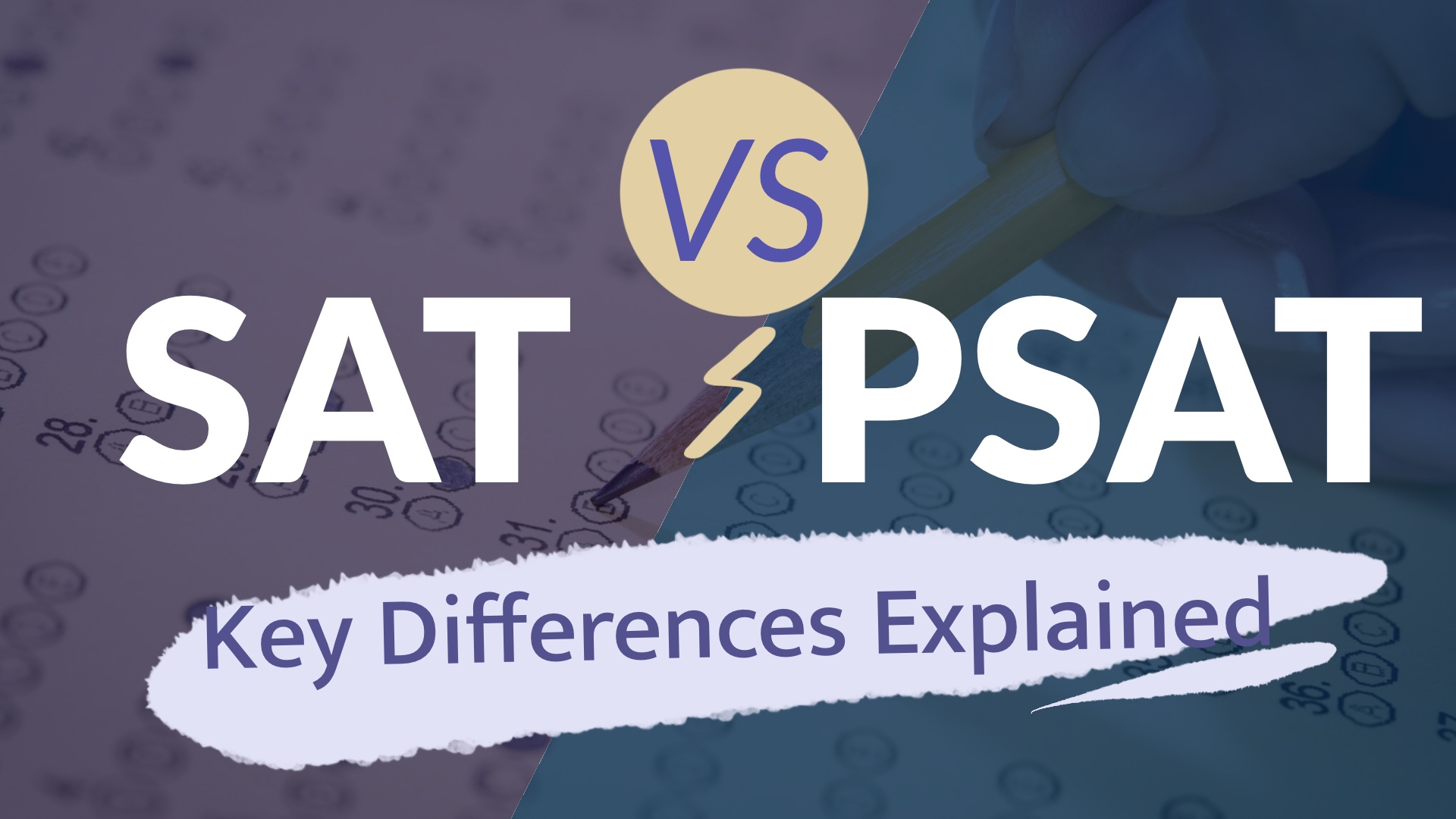PSAT and SAT are both important milestones that can impact your academic opportunities further down the line. By comparing the PSAT vs SAT, it immediately becomes clear that there are plenty of similarities, although there are a couple of notable differences we’ll cover as well. For instance, both are designed to put your reading, writing, and math skills to the test, with the latter generally being more challenging of the two. Suffice it to say that, by preparing for one, you also become readier to take the other. Keep on reading to discover the exam structure, the differences between the two, and how best to prepare.
What is the PSAT?
The PSAT is simply a preliminary version of the SAT, an acronym that originally stood for “Scholastic Aptitude Test”. As a preliminary student, you’re going to do well if you take the time to practice and prepare for what lies ahead. Unlike the SAT, you can only take the PSAT once per year (which, for most students, is going to be in their junior year). Your PSAT results serve as a solid indicator of your college readiness. Moreover, they will give you a strong hint of which areas you should focus on as you go on to make the necessary preparations before taking the SAT. Plus, the PSAT exam serves as a qualifying test for getting the National Merit Scholarship – you need to get to the top 1% just to progress to the semifinals. You will be tested in areas such as math, reading, and writing.
What is the SAT?
In one of our previous articles, we’ve already addressed the most common questions about SAT. Just to reiterate, the SAT is one of the most important exams for undergraduates. Although you won’t need the perfect SAT score to get your foot in the door of the top colleges, it’s still a good idea to perform well, as it is one of the differentiating factors, even among the US colleges with high acceptance rates. The reason is that the SAT exam is used as a basis to gauge your college readiness and assess your academic potential. On top of that, you should strive to get your SAT score at least in the 1300 range or better, since it can help you qualify for a scholarship.
Difference #1: The SAT is generally regarded as the more difficult of the two
When it comes to PSAT vs SAT, the former was designed to be a practice test for the latter, so it’s natural for it to be slightly less challenging. It also tends to be shorter and with fewer questions. Regardless of that, it does a good job of getting you prepared for the real thing.
To get a better idea of how these exams compare in terms of their length, examine the table below:
| Section | PSAT | SAT |
| Reading | 60 minutes, 47 questions | 65 minutes, 52 questions |
| Writing and Language | 35 minutes, 44 questions | 35 minutes, 44 questions |
| Math — No-Calculator | 25 minutes, 17 questions | 25 minutes, 20 questions |
| Math — Calculator | 45 minutes, 31 questions | 55 minutes, 38 questions |
| Total | 2 hours 45 minutes, 139 questions | 3 hours, 154 questions |
Difference #2: The tests are scored in a different manner
When comparing PSAT vs SAT, you need to keep in mind that these have a different scoring structure:
- The PSAT score ranges between 320 and 1520
- The SAT score ranges between 400 and 1600
Although a solid performance on one can be a reliable predictor of how well you’re going to perform on the other, it’s not exactly an exact conversion (although it does come pretty close). To help you determine what percentile you can reach by scoring in a certain range on each of these tests, examine the table below:
| Percentile | PSAT Total Score | SAT Total Score |
| 99+ | 1490-1520 | 1560-1600 |
| 99 | 1460-1480 | 1520-1550 |
| 95 | 1360-1370 | 1430-1440 |
| 90 | 1280 | 1350 |
| 85 | 1230 | 1290 |
| 80 | 1190 | 1240-1250 |
| 75 | 1150 | 1200-1210 |
| 50 | 1000-1010 | 1040-1050 |
Difference #3: The SAT takes place throughout the year
In high school, you will have a total of 3 opportunities to take the PSAT, with each of them coming around only once per year. The SAT, on the other hand, is available multiple times per year, typically during a weekend. To participate, you must register via your school or on the official College Board website.
Difference #4: The SAT is more expensive to take
Depending on the school you’re attending, taking the PSAT can either be free of charge or you will be charged an admission fee of $18. On the other hand, you will be charged $55 every time you take the SAT. Depending on your financial circumstances, however, you may be eligible to have that fee waived. Be careful to register on time, otherwise a $30 late fee may be imposed. Keep in mind that each extra SAT score report you send to colleges with your application could up the total price by $12.
Difference #5: Purpose
Another major difference between the PSAT and the SAT is the purpose. Since the PSAT was mainly designed to be a practice exam for the SAT, it’s nowhere near as important. As a matter of fact, the PSAT is completely optional. Technically speaking, so is the SAT, but we strongly advise you to take at least the latter due to it being the thing that can single-handedly open or close academic opportunities for you (remember that most college officials view it as a requirement). To put it another way: performing poorly in your PSAT will have zero effect on your college admission, but the same cannot be said for the SAT.
Difference #6: There is no essay on the PSAT
If you’re not a fan of writing, there’s good news in the sense that the PSAT does not have an essay section. Even on the SAT, the essay section is entirely optional. Depending on your college of choice, however, taking the essay is what we recommend because it’s something that can give you additional points and be an extra way for your application to stand out.
Similarity #1: Basic structure
When comparing the PSAT vs SAT, it quickly becomes evident they’re not really that different in terms of structure. Both of them feature the following sections:
- Evidence-based reading and writing
- Math
As the name suggests, the former is split into two sections (reading and writing) and so is the latter (calculator and no-calculator sections). For instance, in the reading section, your task will be to interpret a piece of text, and in the writing section, you will be asked to make grammatical and stylistic tweaks. In the SAT Math section, you will be asked to answer both gird-in as well as multiple choice questions.
Similarity #2: Subscores
Although there are slight differences in how the two exams are structured, there is a certain degree of overlap when it comes to subscores, with Analysis in History/Social Studies and Analysis in Science both being good examples. These sections were designed to assess your capacity to think critically. Pay attention to the following subscores – notice they are very similar indeed:
- Command of Evidence
- Words in Context
- Expression of Ideas
- Standard English Conventions
- Heart of Algebra
- Problem Solving and Data Analysis
- Passport to Advanced Math
Similarity #3: No penalty for guessing wrong
In the old days, these tests had a different design. By giving answering incorrectly, you would actually have points deducted from your score. This was implemented to discourage students from guessing randomly to accumulate more points. However, much has changed since the early days and now, you are actually encouraged to take a shot and answer a question, even if you don’t know the right answer, as there is no penalty for missing the mark.
Similarity #4: Content
Above all else, the two exams are similar in the sense of the subject material you’re going to encounter. For instance, both feature:
- Algebra
- Vocab-in-context questions
- etc.
PSAT vs SAT: A side-by-side comparison
As we’ve established, the PSAT and SAT are almost identical in terms of the skills you’re going to need to possess to secure a good score. The PSAT is precisely 15 minutes shorter, doesn’t have an essay section, and is scored on a slightly different scale. To get a better idea of what you can expect, the following side-by-side comparison table should be of help:
| Side-by-side | PSAT | SAT |
|---|---|---|
| Why Take It | PSAT scores determine your eligibility for National Merit Scholarships. | Colleges use SAT scores (and ACT scores) for admissions and merit-based scholarships. |
| Test Structure | • Reading • Writing & Language • Math | • Reading • Writing & Language • Math • Essay (Optional) |
| Length | • 2 hours, 45 minutes | • 3 hours (without essay) • 3 hours, 50 minutes (with essay) |
| How It’s Scored | Scored on a scale of 320–1520 | Scored on a scale of 400–1600 |
How PSAT and SAT prep courses will benefit you
At Novel Prep, we’re observing a massive success rate among students who choose to undertake our SAT preparatory courses. Our students stand to massively benefit from taking an SAT practice test, because it shapes their expectations, lets them self-assess their academic readiness, and gives them valuable hands-on practice to prepare for the real thing. So if you’re still on the fence about taking a SAT exam practice test or enrolling in one of our SAT test prep courses, we strongly encourage you to do so for the following reasons:
You get to boost your confidence
Self-doubt and second thoughts can be very real, and it’s on you to not let these feelings shape your destiny. Why not study for your SAT test with a certified Novel Prep tutor with a proven track record of success?
Make the best use of your time
SAT exam preparation is no easy task: by working with an SAT exam tutor, you’ll be focusing on what actually matters and brings results rather than wasting time on things that simply aren’t as important. At Novel Prep, we will show you how to work smarter, not harder!
Get that much-needed practice
Endlessly consuming various study materials is simply no good if you never get to experience the exam in a realistic setting. With this in mind, our SAT classes have been designed to mirror that experience and will equip you with everything you need to face the real thing.
Conclusion
Now that you know the key similarities and differences between PSAT vs SAT, you’re well on your way to taking the exam and enrolling in the university of your dreams. However, keep in mind that, without proper SAT exam preparation overseen by a certified SAT exam tutor, it’s easy to fall into the trap of over-analyzing certain aspects of it and not giving enough attention to others. Therefore, we strongly advise you to enroll in our SAT prep courses and let us help you just like we have helped thousands of other high school students ace their SAT exams. And, by all means, drop us a line if you still have any questions or doubts – we’re here to help!
FAQs
Does taking the SAT even matter?
Although the SAT exam is now optional, the majority of colleges still examine your SAT score when deciding whether they’re going to admit you or not. The reason is that spaces at these colleges are finite and limited, so the college officials need to make sure to give priority treatment to the most academically gifted.
Can you take the SAT as a senior?
Yes, you can take the SAT as a senior. However, we advise against it, since you might not have enough time to improve your score if you’re not happy with it. It’s best to play your cards right and allow for plenty of opportunities to re-take the test at a later date, so ideally, your first time should be during your junior high school years.
How often is the SAT administered?
In total, you get to take the SAT 7 times a year.
Is your SAT score public?
No. Only the colleges you’ve granted the necessary permissions to view your SAT score. It is by no means open to the public eye.
How often is the PSAT administered?
You get a maximum of 3 shots in total, but no more than 1 per year.
Are the PSAT and SAT scores the same?
They have a similar scoring system, but the ranges differ. For the SAT, your final score will be anything between 400 and 1600, for the PSAT, it can be in the range between 320 and 1520.
What is the purpose of PSAT?
To prepare you for the SAT.
Will college officials look at your PSAT score?
No. They are only interested in your SAT score. Your PSAT score, however, may help you secure certain scholarships.



